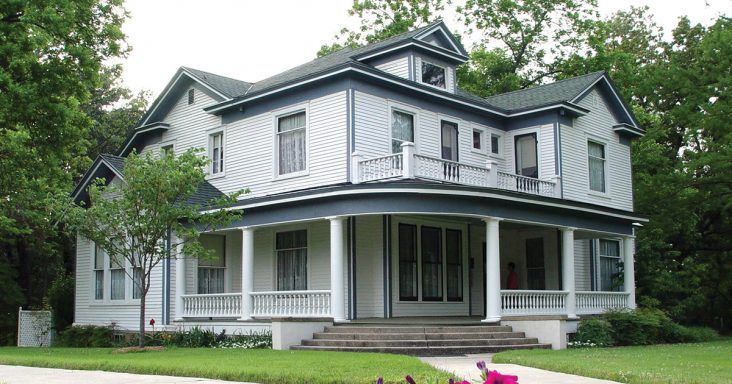Arkansas Heritage Sites are getting a Long
by March 16, 2020 10:44 am 1,003 views

The Hemmingway-Pfeiffer Museum in Piggott.
When Dr. Adam Long started at Lyon College in the fall of 2002, he envisioned a career involving American literature. Nearly 18 years later, his career path has led him to oversee some of the most historic places in Northeast Arkansas.
Long was recently named as the permanent executive director of the Arkansas Heritage Sites at Arkansas State University. He’d been filling that role since June 2019 after former director, Ruth Hawkins, retired. He’d spent the past eight years as the director of the Hemingway-Pfeiffer Museum and Educational Center in Piggott. The other sites include the Southern Tenant Farmers Museum in Tyronza, Lakeport Plantation in Lake Village, and the Historic Dyess Colony: Johnny Cash Boyhood Home in Dyess.
He told Talk Business & Politics about 50,000 tourists per year visit the sites. He’s excited to start his work as the permanent director. One of his main objectives early on will be to develop and expand the educational programs offered by the sites. Those programs will include K-12 offerings as well as an expanded college curriculum.
“That’s going to be a big goal,” he said of the program expansion.
The first heritage site built was the Hemingway-Pfeiffer Museum. Ernest Hemingway, the Nobel Prize and Pulitzer Prize winning author, wrote part of “A Farewell to Arms,” an iconic 20th-century novel, during his many trips to Clay County during the 1930s. He was married to a woman named Pauline Pfeiffer who was from Piggott.
The most surprising thing Long learned as the director of the museum about Hemingway was how much influence his in-laws had on his career during the late 1920s and 1930s. His wife’s family supported him professionally and financially. The family’s role in the writer’s life wasn’t fully examined until the museum opened, he said.
One of the most popular programs at the museum is the summer writer-in-residence. Each June, a writer is brought in and a weeklong retreat is planned, he said.
Hall of Fame Musician Johnny Cash grew up in Dyess during the Great Depression. ASU began restoration on the Cash childhood home in 2011. The dwelling was restored to its original condition and an administrative building built into the old Colony theatre. The project cost about $3.5 million.
The lone construction related project at the sites currently is the Dyess Colony Circle. A new archive and research building is planned and work will begin sometime this spring and should take about a year, Long said. The project will cost about $500,000 and will be paid for with a grant. There are mountains of donated paperwork from the Colony era that will be stored in the archive, he added.
ASU began work on the Lakeport Plantation house in 2001. The house, originally built in 1859, is the last Arkansas plantation house still standing along the Mississippi River. The Lakeport Plantation researches and interprets the people and cultures that shaped plantation life in the Mississippi River Delta, focusing on the Antebellum, Civil War, and Reconstruction periods.
The Lakeport Plantation house was placed on the National Historic Register in 1974 and was designated in 2002 as an official project of the Save America’s Treasures program through the National Park Service and the National Trust for Historic Preservation, according to ASU.
The plantation has remained in continuous cotton production since the 1830s when slaves carved it from the heavily-forested Arkansas frontier. It documents the agricultural development in the region and the accompanying changes in the African-American experience. These changes include the transition from frontier and plantation slavery, to sharecropper and tenant farmer systems, to agricultural mechanization and the resultant mass exodus of African-Americans to factories in the North, to large-scale corporate farming.
No significant construction or renovation plans are under consideration at the Lakeport site at this time, Long said. One of the out buildings on the site will have to be stabilized, however.
The Southern Tenant Farmers Museum is the site of the Southern Tenant Farmers Union’s first headquarters, which operated out of the Tyronza businesses owned by H.L. Mitchell and Clay East in 1934. The museum preserves the memory of sharecropping and tenant farming in the Delta and presents the history of this rare interracial labor union which advocated for the rights and dignity of tenant farming families.
The permanent exhibit also discusses the overall economic system of tenant farming, its integral role in Northeast Arkansas farm life, and how changes in the development of modern agriculture affected farming families as the tenant farming system was replaced with mechanization.
The conflicts that accompanied social and economic change are a core part of the Southern Tenant Farmers Union’s story with divisions between members impacting the union in addition to the sometimes violent opposition they faced.
Long is a 2002 graduate of Jonesboro High School. He received a bachelor of arts degree in English in 2006 from Lyon and a master of arts in American literature in 2008 from the University of Arkansas. He received a Ph.D. in American literature in May 2012 from the University of Kansas.
In his time at ASU, he has taught classes in both English and Heritage Studies. Long has published in the Hemingway Review, the Faulkner Journal and Philological Review, and authored chapters on both Ernest Hemingway and William Faulkner.
How would he try to convince a potential visitor to visit one of the sites?
“These are sites of national impact, located in small towns in the Arkansas Delta … If I had the chance to explain to people who haven’t visited these sites [I’d tell them] how important they are,” he said.
